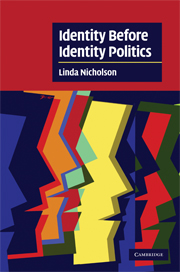Book contents
- Frontmatter
- Contents
- Acknowledgements
- Introduction
- 1 The politics of identity: race and sex before the twentieth century
- Introduction to chapters 2 and 3
- 2 Freud and the rise of the psychological self
- 3 The culture concept and social identity
- Introduction to chapters 4 and 5
- 4 Before Black Power: constructing an African American identity
- 5 Womem's identity/women's politics
- Epilogue: identity politics forty years later: assessing their value
- Index
- Cambridge Cultural Social Studies
Introduction to chapters 2 and 3
Published online by Cambridge University Press: 17 July 2009
- Frontmatter
- Contents
- Acknowledgements
- Introduction
- 1 The politics of identity: race and sex before the twentieth century
- Introduction to chapters 2 and 3
- 2 Freud and the rise of the psychological self
- 3 The culture concept and social identity
- Introduction to chapters 4 and 5
- 4 Before Black Power: constructing an African American identity
- 5 Womem's identity/women's politics
- Epilogue: identity politics forty years later: assessing their value
- Index
- Cambridge Cultural Social Studies
Summary
The “naturalization” of black and female identity that developed in the late eighteenth and nineteenth centuries in the United States and other western countries remained a major current in popular consciousness throughout the twentieth century and even until today. But beginning in the first half of the twentieth century, certain new ways of thinking about identity emerged in Europe and North America to seriously challenge such naturalization. Most importantly, environmentalism became less the position of a small band of intellectuals and more a widely accepted current in popular consciousness. In the process, environmentalism became a more widely available antidote to claims about natural differences.
Environmentalism became a widely accepted current in popular consciousness in part because it became elaborated by various schools of thought that wielded influence both within academic thought and within popular literature. In the next two chapters I will focus on two schools of thought that played an important role in this elaboration and popularization of environmentalism. One such school of thought was dynamic psychology. Dynamic psychology focused on the individual but portrayed individual development less as a function of inborn, natural givens and more as a function of environmental influences. Dynamic psychology was developed in a variety of ways and by a variety of thinkers in the early part of the twentieth century. But I focus on one particularly important contributor, Sigmund Freud, both because of the power of Freud's thought and because of its timing.
- Type
- Chapter
- Information
- Identity Before Identity Politics , pp. 35 - 37Publisher: Cambridge University PressPrint publication year: 2008

